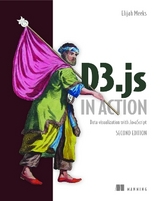
D3.js in Action
Manning Publications (Verlag)
978-1-61729-211-8 (ISBN)
D3.js in Action, a practical tutorial for creating interactive graphics and data driven applications using D3.js, prepares readers to integrate D3.js into their web development process and transform any site into a more engaging and sophisticated user experience. It starts with in-depth explanations of D3's out-of-the-box layouts, along with dozens of practical use cases that align with different types of visualizations. Then, it explores practical techniques for content creation, animation, and representing dynamic data, including interactive graphics and data streamed live over the web. Finally, it shows how to use D3's rich interaction model as the foundation for a complete web application.
RETAIL SELLING POINTS
Dozens of practical use cases
In-depth explanations of D3’s out-of-the-box layouts
Simplifies choosing the right metrics for the job
AUDIENCE
Readers will need basic HTML, CSS, and JavaScript skills. No experience with D3 or SVG required.
ABOUT THE TECHNOLOGY
D3.js is a javascript information visualization library used to create data visualization in the form of traditional charts (scatterplots, histograms, graphs) as well as network diagrams and geographic maps. It’s used by such organizations as the New York Times for its interactive graphics, as well as in industry for real-time dashboards, and in the scholarly community for publication of research in interactive and dynamic form.
Elijah Meeks is a software developer and researcher at Stanford University. His D3.js portfolio includes work with ORBIS and Kindred Britain.
I’ve always loved making games. Board games, role-playing games, computer games—I just love abstracting things into rules, numbers, and categories. As a natural consequence, I’ve always loved data visualization. Damage represented as a bar, spells represented with icons, territory broken down into hexes, treasure charted out in a variety of ways. But it wasn’t until I started working with maps in grad school that I became aware of the immeasurable time and energy people have invested in understanding how to best represent data. I started learning D3 after having worked with databases, map data, and network data in a number of different desktop packages, and also coding in Flash. So I was naturally excited when I was introduced to D3, a JavaScript library that deals not only with information visualization generally, but also with the very specific domains of geospatial data and network data. The fact that it lives in the DOM and follows web standards was a bonus, especially because I’d been working with Flash, which wasn’t known for that kind of thing. Since then, I’ve used D3 for everything, including the creation of UI elements that you’d normally associate with jQuery. When I was approached by Manning to write this book, I thought it would be the perfect opportunity for me to look deeply at D3 and make sure I knew how every little piece of the library worked, while writing a book that didn’t just introduce D3 but really dived into the different pieces of the library that I found so exciting, like mapping and networks, and tied them together. As a result, the book ended up being much longer than I expected and covers everything from the basics of generating lines and areas to using most of the layouts that come to mind when you think of data visualization. It also devotes some space to maps, networks, mobile, and optimization. In the end, I tried to give readers a broad approach to data visualization tools, whether that means maps or networks or pie charts.
| Verlagsort | New York |
|---|---|
| Sprache | englisch |
| Maße | 190 x 230 mm |
| Gewicht | 614 g |
| Einbandart | kartoniert |
| Themenwelt | Informatik ► Datenbanken ► Data Warehouse / Data Mining |
| Informatik ► Web / Internet ► JavaScript | |
| Schlagworte | JavaScript • JavaScript Frameworks • Visualisierung • Visualisierung von Information |
| ISBN-10 | 1-61729-211-7 / 1617292117 |
| ISBN-13 | 978-1-61729-211-8 / 9781617292118 |
| Zustand | Neuware |
| Informationen gemäß Produktsicherheitsverordnung (GPSR) | |
| Haben Sie eine Frage zum Produkt? |
aus dem Bereich



